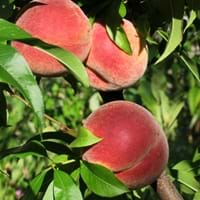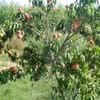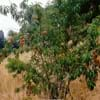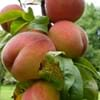Life Span
Perennial
Perennial
Origin
China
Africa, South-Eastern Asia
Types
Not Available
Not Available
Habitat
Sandy Soil
Subtropical forests, Tropical regions
USDA Hardiness Zone
5-9
5-9
Sunset Zone
1a, 1b, 2a, 2b, 3a, 3b, 6, 7, 8, 9, 10, 11, 14
1a, 1b, 2a, 2b, 3a, 3b, 7, 8, 9, 10, 11, 14, 18, 19, 20, 21
Habit
Oval or Rounded
Clump-Forming
Flower Color
White, Light Pink
Pale Yellow, Yellow green
Flower Color Modifier
Bicolor
Bicolor
Fruit Color
Yellow, Peach
Green, Light Green
Leaf Color in Spring
Green
Green
Leaf Color in Summer
Green
Light Green
Leaf Color in Fall
Green
Green, Light Green
Leaf Color in Winter
Light Green
Brown, Light Yellow, Tan
Leaf Shape
Lanceolate
Oval
Plant Season
Spring, Summer, Fall
Summer, Fall, Winter
Sunlight
Full Sun
Full Sun
Growth Rate
Medium
Medium
Type of Soil
Loam, Sand
Clay, Loam, Sand
The pH of Soil
Acidic, Neutral
Acidic, Neutral, Alkaline
Soil Drainage
Well drained
Average
Bloom Time
Spring
Summer, Late Summer, Early Fall
Tolerances
Drought
Pollution, Drought, Salt
Where to Plant?
Ground, Pot
Ground
How to Plant?
Divison, Seedlings, Transplanting
Seedlings, Stem Cutting
Plant Maintenance
Medium
Medium
Watering Requirements
Average Water Needs
Needs less watering
In Summer
Lots of watering
Lots of watering
In Spring
Moderate
Moderate
In Winter
Average Water
Average Water
Soil pH
Acidic, Neutral
Acidic, Neutral, Alkaline
Soil Type
Loam, Sand
Clay, Loam, Sand
Soil Drainage Capacity
Well drained
Average
Sun Exposure
Full Sun
Full Sun
Pruning
Remove damaged leaves, Remove dead branches, Remove dead leaves
A hard prune may be necessary if the plant becomes woody, Cut upper 1/3 section when young to enhancegrowth, Remove damaged leaves, Remove dead branches, Remove dead leaves
Fertilizers
All-Purpose Liquid Fertilizer
10-10-10 diluted liquid fertilizer, All-Purpose Liquid Fertilizer, Compost
Pests and Diseases
Canker, Insects, Mildew, Rust
Aphids, Downy mildew, Purple Blotch, Red blotch
Plant Tolerance
Drought
Drought, Salt and Soil Compaction, Shade areas
Flower Petal Number
Single
Single
Foliage Texture
Medium
Fine
Foliage Sheen
Glossy
Glossy
Attracts
Birds
Bees, Flies, pollinators
Allergy
Not Available
conjunctivitis, sneezing
Aesthetic Uses
Bonsai, Cottage Garden, Formal Garden, Showy Purposes
Not Used For Aesthetic Purpose
Beauty Benefits
Not Available
Making cosmetics, Not Available
Environmental Uses
Air purification
Air purification, Shadow Tree, Soil protection
Medicinal Uses
Antioxidants, Vitamin A, Vitamin B, Vitamin C
Cardiovascular problems, Detoxifies lever, Diabetes, Dysentry, Jaundice, Menstrual Disorders
Part of Plant Used
Flowers, Fruits
Inner Bark, Leaf Stalks
Other Uses
Used As Food
Can be made into a herbal tea, Oil is used for aromatherapy, Used as a fodder tree in agricultural areas
Used As Indoor Plant
No
No
Used As Outdoor Plant
Yes
Yes
Garden Design
Container, Fruit / Fruit Tree, Topiary / Bonsai / Espalier
Dried Flower/Everlasting, Lawns and Turf, Mixed Border, Wildflower
Botanical Name
PRUNUS persica 'Early Elberta'
Terminalia arjuna
Common Name
Early Elberta Peach, Peach, Yellow Freestone Peach
Arjuna
In Hindi
Early Elberta Peach
अर्जुन वृक्ष
In German
Early Elberta Peach
Terminalia arjuna
In French
Early Elberta Peach
Terminalia arjuna
In Spanish
Early Elberta Peach
Migdałecznik arjuna
In Greek
Early Elberta Peach
arjuna
In Portuguese
Early Elberta Peach
Migdałecznik arjuna
In Polish
Early Elberta Peach
Migdałecznik arjuna
In Latin
Early Elberta Peach
arjuna
Phylum
Magnoliophyta
Magnoliophyta
Class
Magnoliopsida
Not Available
Clade
Angiosperms, Eudicots, Rosids
Angiosperms, Eudicots, Rosids
Tribe
Not Available
Not Available
Subfamily
Amygdaloideae
Not Available
Season and Care of Early Elberta Peach and Arjuna Tree
Season and care of Early Elberta Peach and Arjuna Tree is important to know. While considering everything about Early Elberta Peach and Arjuna Tree Care, growing season is an essential factor. Early Elberta Peach season is Spring, Summer and Fall and Arjuna Tree season is Spring, Summer and Fall. The type of soil for Early Elberta Peach is Loam, Sand and for Arjuna Tree is Clay, Loam, Sand while the PH of soil for Early Elberta Peach is Acidic, Neutral and for Arjuna Tree is Acidic, Neutral, Alkaline.
Early Elberta Peach and Arjuna Tree Physical Information
Early Elberta Peach and Arjuna Tree physical information is very important for comparison. Early Elberta Peach height is 150.00 cm and width 150.00 cm whereas Arjuna Tree height is 300.00 cm and width 45.70 cm. The color specification of Early Elberta Peach and Arjuna Tree are as follows:
Early Elberta Peach flower color: White and Light Pink
Early Elberta Peach leaf color: Green
Arjuna Tree flower color: Pale Yellow and Yellow green
- Arjuna Tree leaf color: Green
Care of Early Elberta Peach and Arjuna Tree
Care of Early Elberta Peach and Arjuna Tree include pruning, fertilizers, watering etc. Early Elberta Peach pruning is done Remove damaged leaves, Remove dead branches and Remove dead leaves and Arjuna Tree pruning is done A hard prune may be necessary if the plant becomes woody, Cut upper 1/3 section when young to enhancegrowth, Remove damaged leaves, Remove dead branches and Remove dead leaves. In summer Early Elberta Peach needs Lots of watering and in winter, it needs Average Water. Whereas, in summer Arjuna Tree needs Lots of watering and in winter, it needs Average Water.





